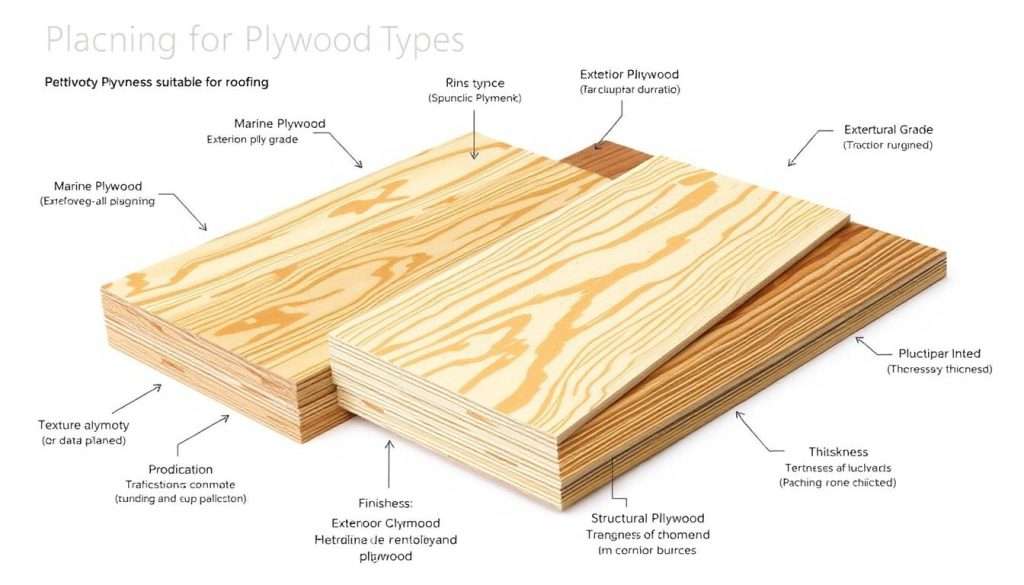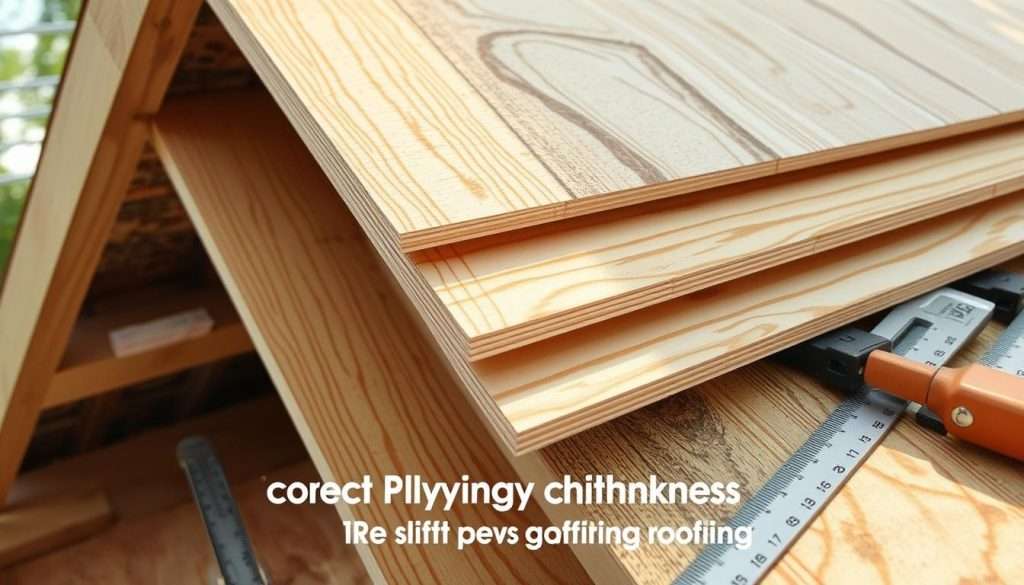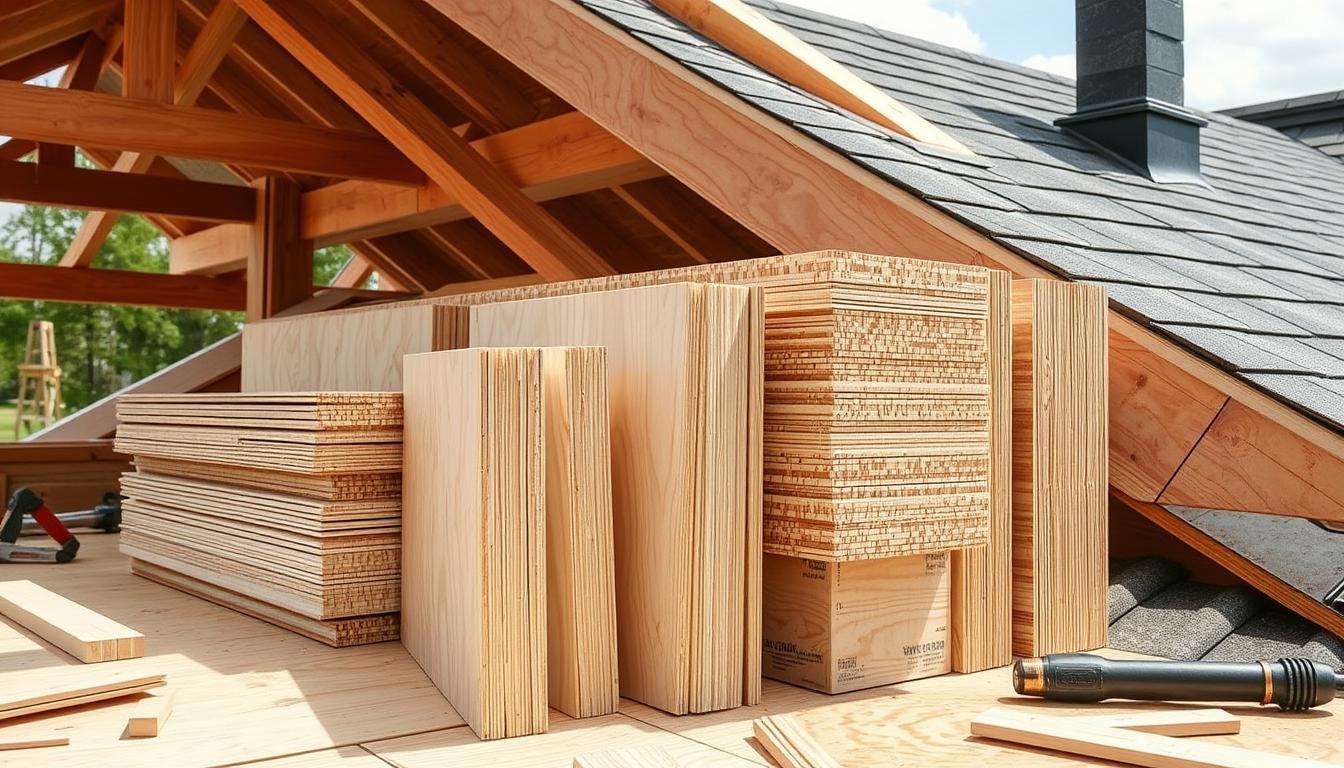Choosing the right what thickness plywood for roof sheathing is key for a strong roof. This layer supports the roof materials, affecting its strength and leak risk. Most roofs need sheathing from 1/2 inch to 5/8 inches thick.
For asphalt shingle roofs, 5/8 inch is often recommended. Metal roofs, being heavier, might need 3/4 inch or more.
Knowing the plywood roof thickness needed is vital for weather protection. Codes say sheathing must be at least 19/32 inches thick for safety. But remember, plywood can peel over time, so it needs care. For more on choosing the right plywood, check out this link.
The ideal plywood thickness for roofing depends on many things. These include the weather, how much weight the roof can hold, and local building rules. So, it’s important to think about these factors carefully before making a choice.
Understanding Plywood Types and Grades
When you start roofing projects, knowing about plywood types and grades is key. Choosing the right plywood means your roof will last long and look good. We’ll explore the different types and grades that affect the best plywood for roofs.
Different Types of Plywood for Roofing
Knowing the different plywood types helps you pick the best for your roof. Here are some common ones:
- Softwood Plywood: Comes in grades A, B, C, and D, great for many roofs.
- Hardwood Plywood: Made from birch, maple, and oak, it’s strong and stable.
- Marine Grade Plywood: Made for places where water stays for a long time.
- Pressure-Treated Plywood: Has chemicals to fight mold and mildew, good for outdoors.
- CDX Sheathing Plywood: A budget-friendly option from lower grades C and D, used for roofs and garages.

Plywood Grades and Their Impact on Thickness
The grade of plywood affects its look, strength, and thickness. Here’s a look at the grades:
| Grade | Description | Typical Use |
|---|---|---|
| A | High quality, smooth surface, easy to paint | Furniture, exposed structures |
| B | Good quality with minor imperfections | Cabinets, decorative surfaces |
| C | Visible flaws allowed, knots up to 1.5 inches | General construction |
| D | Cheapest, can have large flaws and knots | Subfloors, hidden surfaces |
Plywood thickness varies, from 1/8-inch to 3/4-inch. For roofs, 1/2-inch thick plywood is often the best. Looking at plywood grades helps pick the right thickness for your roof. This ensures it’s strong and works well in different weather.
Factors to Consider for Plywood Thickness
Choosing the right plywood thickness for your roof is key. It affects how long and safe your roof will be.
Roof Design and Load Requirements
Roof designs need different strengths based on weather and style. Here are some common plywood thicknesses:
- 3/8 inch: Used in some old buildings but might not be strong enough.
- 7/16 inch: Good for most roofs, especially where it snows a bit.
- 1/2 inch: Best for places with strong winds or lots of snow.
- 5/8 inch: Needed for very bad weather or long roofs.
Environmental Considerations
Weather affects how thick your plywood should be. Places with lots of snow or wind need thicker plywood. For example, 30 pounds of snow per square foot needs the right plywood size.
Good air flow in your roof helps plywood last longer. It stops moisture problems.
Building Codes and Regulations
Following local building codes is very important. These codes say how thick your roof sheathing must be, usually 19/32 inches. Check your area’s rules to make sure your roof meets them.

Recommended Thicknesses for Common Roof Types
Choosing the right plywood thickness for your roof is key. It keeps your roof strong and lasts longer. Each roof type needs a specific plywood thickness to handle loads and weather.
Asphalt Shingle Roofs
Asphalt shingle roofs usually need 1/2 inch or 5/8 inch CDX plywood. This thickness supports the shingles well and lasts a long time. Make sure to check the rafter spacing. For example, half-inch CDX plywood works for 24-inch spacing.
If your roof has heavier loads, choose three-fourths-inch plywood. This adds more stability.
Metal Roofs
Metal roofs need a strong base. A plywood thickness of at least 5/8 inch is best. Thicker plywood helps your roof perform better, especially in bad weather.
It also makes your roof less likely to warp or get damaged.
Flat Roofs
Flat roofs face special challenges like drainage and load support. You might need 3/4 inch to 1 inch plywood thickness. This depends on the weight of insulation and roofing.
Thicker sheathing helps prevent sagging. It makes your roof deck more reliable over time.
| Roof Type | Recommended Plywood Thickness | Remarks |
|---|---|---|
| Asphalt Shingle Roof | 1/2 inch to 5/8 inch | Supports typical loads |
| Metal Roof | 5/8 inch | Enhances stability against harsh conditions |
| Flat Roof | 3/4 inch to 1 inch | Prevents sagging and enhances durability |
Installation Tips for Plywood Roofing
Putting plywood on your roof right is key to a strong roof. Good tips for installing plywood help a lot. Paying close attention to details is very important.
Preparing the Roof Structure
First, make sure the roof is ready for plywood. Check the rafters or trusses for damage or rot. Fixing or replacing them makes your roof better.
Then, clean the roof of old stuff and debris. This makes it easier to work on. Also, make sure there’s good air flow to stop moisture problems.
Securing Plywood Properly
It’s very important to fasten plywood well. Use strong fasteners like stainless steel or galvanized steel. This keeps the plywood tight to the rafters.
Keep the plywood straight and evenly spaced. This stops gaps or overlaps. Always follow the fastener spacing advice from the maker for the best results.
Insulation Considerations
Insulation is very important for your roof. It keeps your home warm and stops moisture. Pick insulation that goes well with your roof materials.
Put insulation down before the plywood. This makes it work better. The right insulation keeps your home comfy and protects your roof.
| Roof Type | Recommended Plywood Thickness | Notes |
|---|---|---|
| Asphalt Shingle Roof | 5/8 inches | Minimum thickness for structural integrity. |
| Metal Roof | 3/4 inches | Higher weight requires increased thickness. |
| Low-Slope Roof | 3/4 inches | Additional protection against water damage. |
| Conventional Roofing | 1/2 to 5/8 inches | Common thickness choices for residential roofs. |
| Exterior Gypsum Board | Varies | Dependent on material and application. |
Maintenance and Longevity of Plywood Roofs
It’s important to know how to take care of plywood roofs. Regular checks can spot problems early. Look for cracks, color changes, or sagging.
Also, watch the joints and seams for moisture. This can cause rot and damage.
Signs of Wear and Tear
Spotting plywood wear early can save money. Look for water stains or uneven spots. These could mean your roof is failing.
Excessive moisture or dark spots in the attic are bad signs. They mean your plywood might not be working right.
Best Practices for Maintenance
Keep your plywood roof in good shape with regular care. Clean gutters and downspouts often. This helps water flow away from your roof.
Check your roof every six months and after bad weather. Look closely at seams and vents. Make sure your plywood is thick enough.
When to Replace Plywood Roofing
Knowing when to replace your roof is key. Look for rot, mold, or big damage. If your plywood is too thin, it’s a problem.
Choose high-quality plywood for a longer-lasting roof. Good materials make a big difference.
